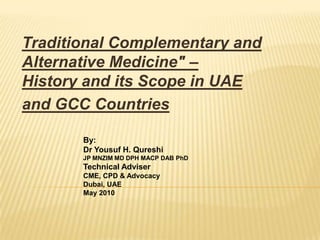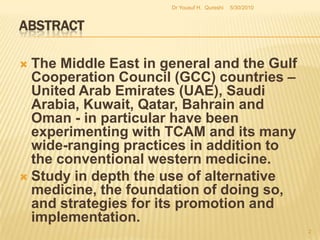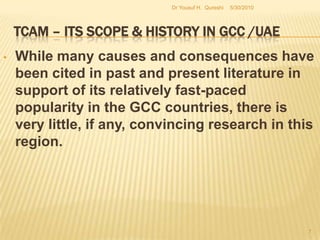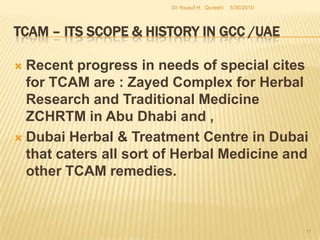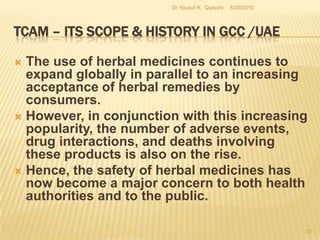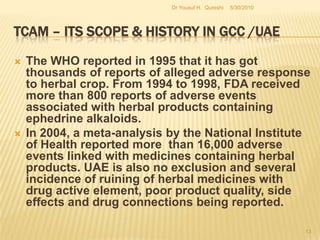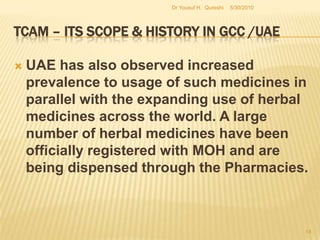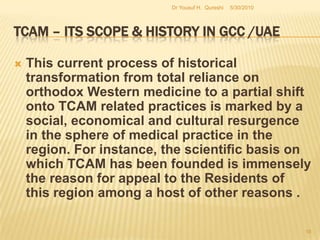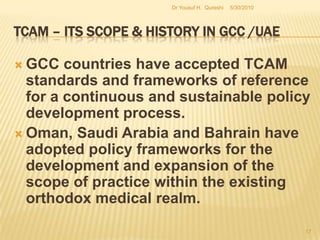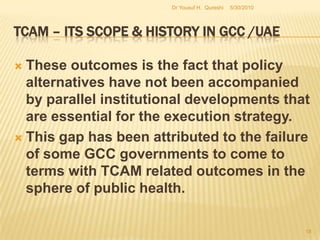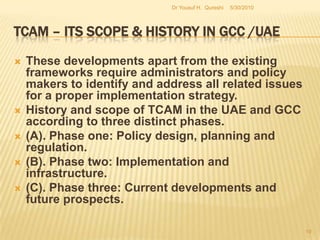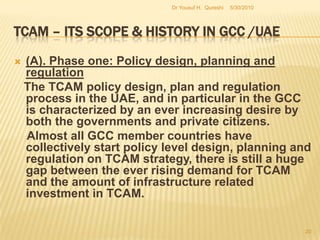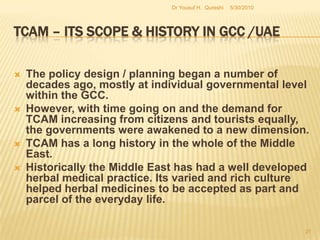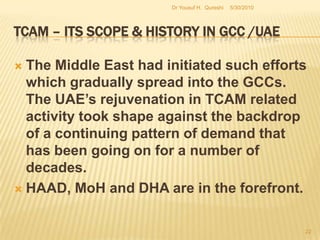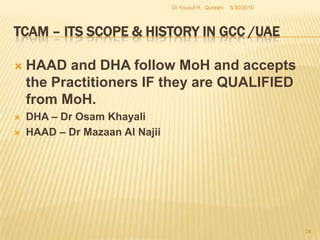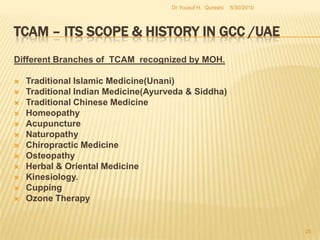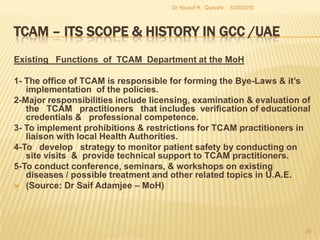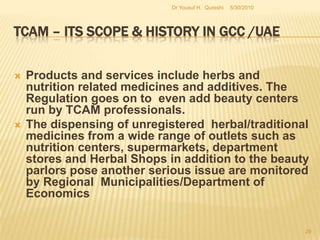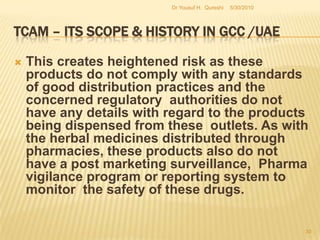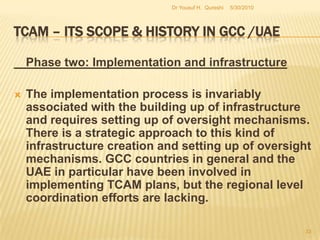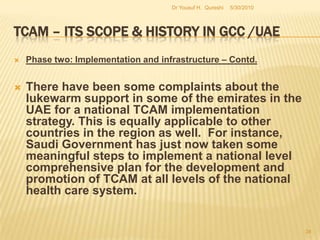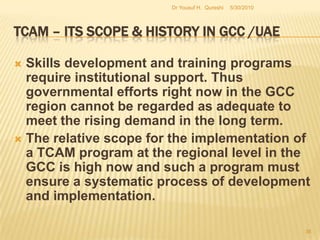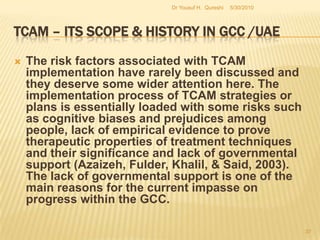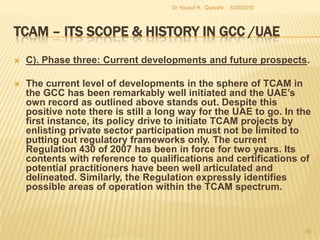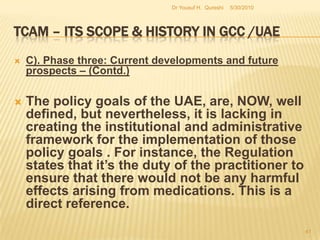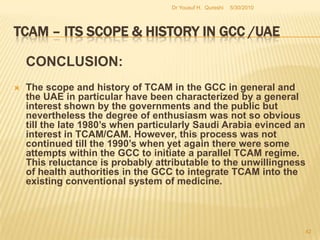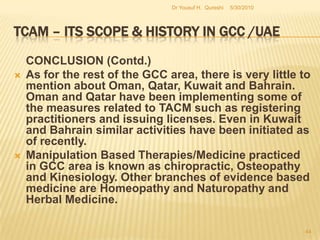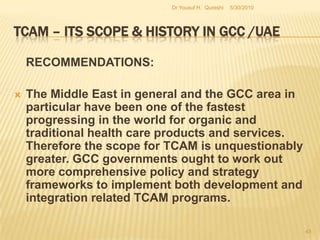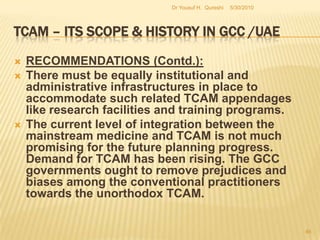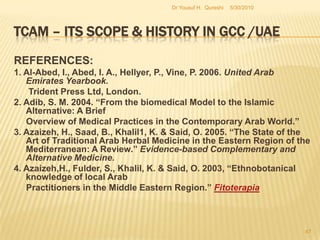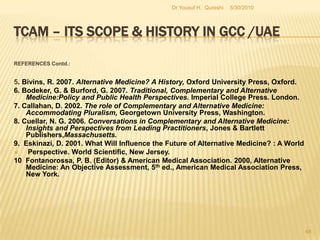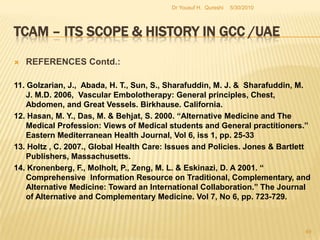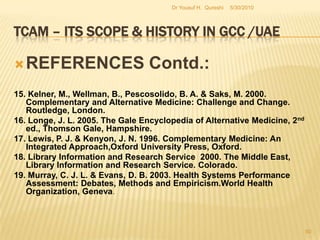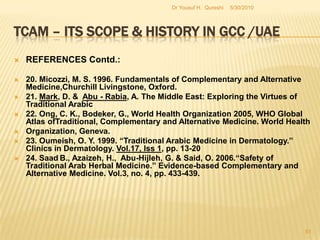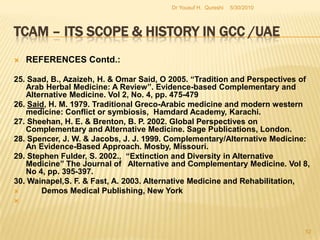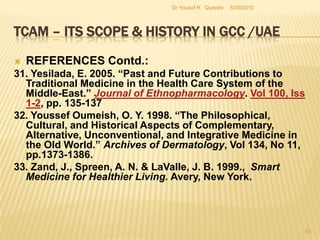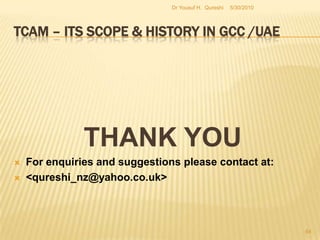Tcam ppp 270510
- 1. ╠²╠²╠²╠²╠²Traditional Complementary and Alternative Medicine" ŌĆō History and its Scope in UAE and GCC CountriesBy:Dr Yousuf H. Qureshi JP MNZIM MD DPH MACP DAB PhDTechnical Adviser CME, CPD & AdvocacyDubai, UAEMay 2010
- 2. AbstractThe Middle East in general and the Gulf Cooperation Council (GCC) countries ŌĆō United Arab Emirates (UAE), Saudi Arabia, Kuwait, Qatar, Bahrain and Oman - in particular have been experimenting with TCAM and its many wide-ranging practices in addition to the conventional western medicine.Study in depth the use of alternative medicine, the foundation of doing so, and strategies for its promotion and implementation. 5/27/20102Dr Yousuf H. Qureshi
- 3. Abstract ŌĆō (Contd.)Classify biases in communication building efforts in favor of the conventional medicine and the risk factors involved in the execution of TCAM. Discusses the past and scope of TCAM in the UAE and GCC countries as to their rule design, planning and regulation, implementation and infrastructure, current developments and future prospects.5/27/2010Dr Yousuf H. Qureshi3
- 4. TCAM ŌĆō Its Scope & History in GCC /UAEAccording to current estimates the UAEŌĆÖs market for herbal drugs and related services are in the vicinity of AED 300 million per year, which is almost one quarter of the approximate total $330 million for all drugs. Use of herbal medicines continues to expand globally in parallel to an increasing acceptance of herbal remedies by consumers.5/27/20104Dr Yousuf H. Qureshi
- 5. TCAM ŌĆō Its Scope & History in GCC /UAEA large number of herbal medicines have been officially registered with MOH and is being dispensed through the pharmacies. This current process of historical transformation from total reliance on orthodox Western medicine to partial shift onto TCAM related practices is marked by a social, economical and cultural resurgence in the sphere of medical practice in the region.5/27/2010Dr Yousuf H. Qureshi5
- 6. TCAM ŌĆō Its Scope & History in GCC /UAETCAM is a set of unlike medical and health care schemes, practices, and products that are not generally careful part of conventional medicine.
- 7. The term' ConventionalŌĆÖ refers to all medical practices related to allopathic medicine. While TraditionalŌĆÖ entirely refers to such practices connected with Herbal Remedies, Naturopathy, Ayurvedic and Homeopathic medicine, Chinese traditional medicine, Hypnotherapy, and many others.
- 8. The list of alternative therapies is never ending because there are as many alternative and complementary therapies as there are many countries and regions in the world. 5/27/2010Dr Yousuf H. Qureshi6
- 9. TCAM ŌĆō Its Scope & History in GCC /UAEWhile many causes and consequences have been cited in past and present literature in support of its relatively fast-paced popularity in the GCC countries, there is very little, if any, convincing research in this region.5/27/20107Dr Yousuf H. Qureshi
- 10. TCAM ŌĆō Its Scope & History in GCC /UAEA framework published by HAAD have sought to clear the scope of the practice for any budding practitioner who may hope to record with the HAAD. HAAD does not expand to other emirates of the UAE, there is a general force in accepting such frameworks within the UAE for all point and intents.Dubai and Sharjah are the most popular places for TCAM Practitioners in the UAE. 5/27/2010Dr Yousuf H. Qureshi8
- 11. TCAM ŌĆō Its Scope & History in GCC /UAEPractice of TCAM can be explained by categorizing them as follows:Traditional Islamic/Greeko-Arab/Unani Medicine: Unani Medicine: although the text is from Greek (UNAN) it derives a major influence from Islam and is also referred to as Eastern Medicine in some countries.Cupping (Hujjama)Tibbe ŌĆō Nabawi5/27/2010Dr Yousuf H. Qureshi9
- 12. TCAM ŌĆō Its Scope & History in GCC /UAETraditional Chinese Medicine:This includes Chinese Herbal Medicines and Acupuncture.Acupuncture and Moxibustion.Tuina ŌĆō Chinese massageTraditional Indian Medicine: Ayurveda ŌĆō It includes ayurveda herbal medicine practice, ayurveda massage and yoga.HomeopathyNaturopathy5/27/201010Dr Yousuf H. Qureshi
- 13. TCAM ŌĆō Its Scope & History in GCC /UAERecent progress in needs of special cites for TCAM are : Zayed Complex for Herbal Research and Traditional Medicine ZCHRTM in Abu Dhabi and , Dubai Herbal & Treatment Centre in Dubai that caters all sort of Herbal Medicine and other TCAM remedies.5/27/2010Dr Yousuf H. Qureshi11
- 14. TCAM ŌĆō Its Scope & History in GCC /UAEThe use of herbal medicines continues to expand globally in parallel to an increasing acceptance of herbal remedies by consumers. However, in conjunction with this increasing popularity, the number of adverse events, drug interactions, and deaths involving these products is also on the rise.Hence, the safety of herbal medicines has now become a major concern to both health authorities and to the public. 5/27/2010Dr Yousuf H. Qureshi12
- 15. TCAM ŌĆō Its Scope & History in GCC /UAEThe WHO reported in 1995 that it has got thousands of reports of alleged adverse response to herbal crop. From 1994 to 1998, FDA received more than 800 reports of adverse events associated with herbal products containing ephedrine alkaloids.In 2004, a meta-analysis by the National Institute of Health reported more than 16,000 adverse events linked with medicines containing herbal products. UAE is also no exclusion and several incidence of ruining of herbal medicines with drug active element, poor product quality, side effects and drug connections being reported. 5/27/2010Dr Yousuf H. Qureshi13
- 16. TCAM ŌĆō Its Scope & History in GCC /UAEUAE has also observed increased prevalence to usage of such medicines in parallel with the expanding use of herbal medicines across the world. A large number of herbal medicines have been officially registered with MOH and are being dispensed through the Pharmacies.5/27/2010Dr Yousuf H. Qureshi14
- 17. TCAM ŌĆō Its Scope & History in GCC /UAEMany pharmacists are unaware of the dispensing mode mandated by MOH for these drugs and readily dispense them with the false notion that they are registered as over the counter drugs. Pharmacists are also inadequately learned about the safety of herbal remedies and potential interactions involving herbal products. Moreover, people are more willing to consume herbal remedies.5/27/2010Dr Yousuf H. Qureshi15
- 18. TCAM ŌĆō Its Scope & History in GCC /UAEThis current process of historical transformation from total reliance on orthodox Western medicine to a partial shift onto TCAM related practices is marked by a social, economical and cultural resurgence in the sphere of medical practice in the region. For instance, the scientific basis on which TCAM has been founded is immensely the reason for appeal to the Residents of this region among a host of other reasons .5/27/2010Dr Yousuf H. Qureshi16
- 19. TCAM ŌĆō Its Scope & History in GCC /UAEGCC countries have accepted TCAM standards and frameworks of reference for a continuous and sustainable policy development process. Oman, Saudi Arabia and Bahrain have adopted policy frameworks for the development and expansion of the scope of practice within the existing orthodox medical realm. 5/27/2010Dr Yousuf H. Qureshi17
- 20. TCAM ŌĆō Its Scope & History in GCC /UAEThese outcomes is the fact that policy alternatives have not been accompanied by parallel institutional developments that are essential for the execution strategy. This gap has been attributed to the failure of some GCC governments to come to terms with TCAM related outcomes in the sphere of public health. 5/27/2010Dr Yousuf H. Qureshi18
- 21. TCAM ŌĆō Its Scope & History in GCC /UAEThese developments apart from the existing frameworks require administrators and policy makers to identify and address all related issues for a proper implementation strategy. History and scope of TCAM in the UAE and GCC according to three distinct phases.(A). Phase one: Policy design, planning and regulation.(B). Phase two: Implementation and infrastructure.(C). Phase three: Current developments and future prospects.5/27/2010Dr Yousuf H. Qureshi19
- 22. TCAM ŌĆō Its Scope & History in GCC /UAE(A). Phase one: Policy design, planning and regulationThe TCAM policy design, plan and regulation process in the UAE, and in particular in the GCC is characterized by an ever increasing desire by both the governments and private citizens. Almost all GCC member countries have collectively start policy level design, planning and regulation on TCAM strategy, there is still a huge gap between the ever rising demand for TCAM and the amount of infrastructure related investment in TCAM.5/27/2010Dr Yousuf H. Qureshi20
- 23. TCAM ŌĆō Its Scope & History in GCC /UAEThe policy design / planning began a number of decades ago, mostly at individual governmental level within the GCC. However, with time going on and the demand for TCAM increasing from citizens and tourists equally, the governments were awakened to a new dimension. TCAM has a long history in the whole of the Middle East.Historically the Middle East has had a well developed herbal medical practice. Its varied and rich culture helped herbal medicines to be accepted as part and parcel of the everyday life. 5/27/2010Dr Yousuf H. Qureshi21
- 24. TCAM ŌĆō Its Scope & History in GCC /UAEThe Middle East had initiated such efforts which gradually spread into the GCCs. The UAEŌĆÖs rejuvenation in TCAM related activity took shape against the backdrop of a continuing pattern of demand that has been going on for a number of decades. HAAD, MoH and DHA are in the forefront. 5/27/2010Dr Yousuf H. Qureshi22
- 25. TCAM ŌĆō Its Scope & History in GCC /UAEMoH has a Regular Set up of TCAM Department started a few years ago with clear Regulations for ACCEPTING the TCAM Practitioners:Recognizing the QualificationsProper Registration for Examination Clearly Specified Examination ProceduresStringent Quality in awarding the RegistrationDrs WafaHossaini & SaifAdamjee run the Department efficiently5/27/2010Dr Yousuf H. Qureshi23
- 26. TCAM ŌĆō Its Scope & History in GCC /UAEHAAD and DHA follow MoH and accepts the Practitioners IF they are QUALIFIED from MoH.DHA ŌĆō Dr OsamKhayaliHAAD ŌĆō Dr Mazaan Al Najii5/27/2010Dr Yousuf H. Qureshi24
- 27. TCAM ŌĆō Its Scope & History in GCC /UAEDifferent Branches of TCAM recognized by MOH.╠²Traditional Islamic Medicine(Unani)Traditional Indian Medicine(Ayurveda & Siddha)Traditional Chinese MedicineHomeopathyAcupunctureNaturopathyChiropractic MedicineOsteopathyHerbal & Oriental MedicineKinesiology.CuppingOzone Therapy5/27/2010Dr Yousuf H. Qureshi25
- 28. TCAM ŌĆō Its Scope & History in GCC /UAEExisting Functions of TCAM Department at the MoH1- The office of TCAM is responsible for forming the Bye-Laws & itŌĆÖs implementation of the policies. 2-Major responsibilities include licensing, examination & evaluation of the TCAM practitioners that includes verification of educational credentials & professional competence.3- To implement prohibitions & restrictions for TCAM practitioners in liaison with local Health Authorities. 4-To develop strategy to monitor patient safety by conducting on site visits & provide technical support to TCAM practitioners.5-To conduct conference, seminars, & workshops on existing diseases / possible treatment and other related topics in U.A.E. (Source: Dr SaifAdamjee ŌĆō MoH)5/27/2010Dr Yousuf H. Qureshi26
- 29. TCAM ŌĆō Its Scope & History in GCC /UAEThe regulatory frameworks developed in conformance with international norms in other regions have been the central point of focus due to what could be termed as ŌĆ£Compliance parameters and Ethical practice-based conceptsŌĆØ. Substantial proportions of herbal medicines are registered with MOH, they come directly into the market without stringent quality analysis or prior post-marketing safety monitoring. Moreover, a large number of unregistered herbal medicines are also dispensed from a wide range of outlets other than pharmacies with serious implications on patient safety.5/27/2010Dr Yousuf H. Qureshi27
- 30. TCAM ŌĆō Its Scope & History in GCC /UAETo strengthen MOHŌĆÖs capacity in monitoring the safety of herbal medicine in the U.A.E. through a program of post market monitoring and surveillance. As well as to analyze the causes of adverse events and to share safety information at national, regional and global levels.To obtain a comprehensive coverage, herbal products can be placed into the following categories:Herbal medicines in the prescription medicines category. Herbal medicines in the non-prescription medicines category. 5/27/2010Dr Yousuf H. Qureshi28
- 31. TCAM ŌĆō Its Scope & History in GCC /UAEProducts and services include herbs and nutrition related medicines and additives. The Regulation goes on to even add beauty centers run by TCAM professionals. The dispensing of unregistered herbal/traditional medicines from a wide range of outlets such as nutrition centers, supermarkets, department stores and Herbal Shops in addition to the beauty parlors pose another serious issue are monitored by Regional Municipalities/Department of Economics5/27/2010Dr Yousuf H. Qureshi29
- 32. TCAM ŌĆō Its Scope & History in GCC /UAEThis creates heightened risk as these products do not comply with any standards of good distribution practices and the concerned regulatory authorities do not have any details with regard to the products being dispensed from these outlets. As with the herbal medicines distributed through pharmacies, these products also do not have a post marketing surveillance, Pharma vigilance program or reporting system to monitor the safety of these drugs.5/27/2010Dr Yousuf H. Qureshi30
- 33. TCAM ŌĆō Its Scope & History in GCC /UAEAccording to the qualification of TCAM the MoH recognize:The Practitioner: holding a degree/diploma can be termed as a physician/practitioner with respect to the length of their training and the nature of their education.The Therapist: holding a diploma to carry out Massage/Procedure must work only under the supervision of a TCAM practitioner.5/27/2010Dr Yousuf H. Qureshi31
- 34. TCAM ŌĆō Its Scope & History in GCC /UAEThe UAEŌĆÖs current policy design and planning process needs to be analyzed with reference to the larger GCC context. The GCC countries have been promoting TCAM on the basis of a comprehensive national policy which requires the adoption of TCAM at the national/regional level to complement the existing conventional medical practice and services.Beginning with the procuring of license, credentials and insurance, the GCCŌĆÖs own record has been marred by an obvious absence of policy related developments (Holtz , 2007).5/27/2010Dr Yousuf H. Qureshi32
- 35. TCAM ŌĆō Its Scope & History in GCC /UAE Phase two: Implementation and infrastructureThe implementation process is invariably associated with the building up of infrastructure and requires setting up of oversight mechanisms. There is a strategic approach to this kind of infrastructure creation and setting up of oversight mechanisms. GCC countries in general and the UAE in particular have been involved in implementing TCAM plans, but the regional level coordination efforts are lacking. 5/27/2010Dr Yousuf H. Qureshi33
- 36. TCAM ŌĆō Its Scope & History in GCC /UAEPhase two: Implementation and infrastructure ŌĆō Contd.There have been some complaints about the lukewarm support in some of the emirates in the UAE for a national TCAM implementation strategy. This is equally applicable to other countries in the region as well. For instance, Saudi Government has just now taken some meaningful steps to implement a national level comprehensive plan for the development and promotion of TCAM at all levels of the national health care system.5/27/2010Dr Yousuf H. Qureshi34
- 37. TCAM ŌĆō Its Scope & History in GCC /UAESocial infrastructures such as schools, universities, colleges, hospitals, infirmaries, herbariums and hospices need to be built up with the active participation of the government. The relative scope for the implementation of a TCAM program at the regional level in the GCC is high now and such a program must ensure a systematic process of development and implementation. 5/27/2010Dr Yousuf H. Qureshi35
- 38. TCAM ŌĆō Its Scope & History in GCC /UAESkills development and training programs require institutional support. Thus governmental efforts right now in the GCC region cannot be regarded as adequate to meet the rising demand in the long term.The relative scope for the implementation of a TCAM program at the regional level in the GCC is high now and such a program must ensure a systematic process of development and implementation.5/27/2010Dr Yousuf H. Qureshi36
- 39. TCAM ŌĆō Its Scope & History in GCC /UAEThe risk factors associated with TCAM implementation have rarely been discussed and they deserve some wider attention here. The implementation process of TCAM strategies or plans is essentially loaded with some risks such as cognitive biases and prejudices among people, lack of empirical evidence to prove therapeutic properties of treatment techniques and their significance and lack of governmental support (Azaizeh, Fulder, Khalil, & Said, 2003). The lack of governmental support is one of the main reasons for the current impasse on progress within the GCC.5/27/2010Dr Yousuf H. Qureshi37
- 40. TCAM ŌĆō Its Scope & History in GCC /UAEEvidence based TCAM requires such implementation strategies effectively backed by administrative and institutional infrastructures.Lack of interest in initiating a systematic national program on TCAM in the past in the GCC and the UAE.Fear that investment in new social infrastructure considered to be unyielding in profits. This predicament has been one of the underlying causes for the snail-pace progress in setting up infrastructures and institutional frameworks in the GCC in general and the UAE in particular. 5/27/2010Dr Yousuf H. Qureshi38
- 41. TCAM ŌĆō Its Scope & History in GCC /UAEThe UAE health authorities were much influenced by the current thinking that rushing into unconventional medicine could jeopardize the ongoing research work on mainstream medicine funded by various outside organizations and governments. The GCC as a whole had the same attitude except Saudi Arabia which was seeking to widen the choices available to patients. Thus it is within a limited geographical expanse that TCAM was sought to be propagated. 5/27/2010Dr Yousuf H. Qureshi39
- 42. TCAM ŌĆō Its Scope & History in GCC /UAEC). Phase three: Current developments and future prospects.The current level of developments in the sphere of TCAM in the GCC has been remarkably well initiated and the UAEŌĆÖs own record as outlined above stands out. Despite this positive note there is still a long way for the UAE to go. In the first instance, its policy drive to initiate TCAM projects by enlisting private sector participation must not be limited to putting out regulatory frameworks only. The current Regulation 430 of 2007 has been in force for two years. Its contents with reference to qualifications and certifications of potential practitioners have been well articulated and delineated. Similarly, the Regulation expressly identifies possible areas of operation within the TCAM spectrum. 5/27/2010Dr Yousuf H. Qureshi40
- 43. TCAM ŌĆō Its Scope & History in GCC /UAEC). Phase three: Current developments and future prospects ŌĆō (Contd.)The policy goals of the UAE, are, NOW, well defined, but nevertheless, it is lacking in creating the institutional and administrative framework for the implementation of those policy goals . For instance, the Regulation states that itŌĆÖs the duty of the practitioner to ensure that there would not be any harmful effects arising from medications. This is a direct reference. 5/27/2010Dr Yousuf H. Qureshi41
- 44. TCAM ŌĆō Its Scope & History in GCC /UAECONCLUSION:The scope and history of TCAM in the GCC in general and the UAE in particular have been characterized by a general interest shown by the governments and the public but nevertheless the degree of enthusiasm was not so obvious till the late 1980ŌĆÖs when particularly Saudi Arabia evinced an interest in TCAM/CAM. However, this process was not continued till the 1990ŌĆÖs when yet again there were some attempts within the GCC to initiate a parallel TCAM regime. This reluctance is probably attributable to the unwillingness of health authorities in the GCC to integrate TCAM into the existing conventional system of medicine. 5/27/2010Dr Yousuf H. Qureshi42
- 45. TCAM ŌĆō Its Scope & History in GCC /UAECONCLUSION (Contd.):The UAEŌĆÖs experience has been similarly characterized by an on-and-off commitment to initiate TCAM related policy measures (Zand, Spreen & LaValle, 1999). Above all, nothing substantial in relation to TCAM practices was implemented by the UAE as a whole or by any of the emirates individually. However, its current progress requires special mention for there is no parallel for its Zayed Complex for Herbal Research and Traditional Medicine in the entire Middle East. 5/27/2010Dr Yousuf H. Qureshi43
- 46. TCAM ŌĆō Its Scope & History in GCC /UAE CONCLUSION (Contd.)As for the rest of the GCC area, there is very little to mention about Oman, Qatar, Kuwait and Bahrain. Oman and Qatar have been implementing some of the measures related to TACM such as registering practitioners and issuing licenses. Even in Kuwait and Bahrain similar activities have been initiated as of recently. Manipulation Based Therapies/Medicine practiced in GCC area is known as chiropractic, Osteopathy and Kinesiology. Other branches of evidence based medicine are Homeopathy and Naturopathy and Herbal Medicine. 5/27/2010Dr Yousuf H. Qureshi44
- 47. TCAM ŌĆō Its Scope & History in GCC /UAE RECOMMENDATIONS:The Middle East in general and the GCC area in particular have been one of the fastest progressing in the world for organic and traditional health care products and services. Therefore the scope for TCAM is unquestionably greater. GCC governments ought to work out more comprehensive policy and strategy frameworks to implement both development and integration related TCAM programs.5/27/2010Dr Yousuf H. Qureshi45
- 48. TCAM ŌĆō Its Scope & History in GCC /UAERECOMMENDATIONS (Contd.):There must be equally institutional and administrative infrastructures in place to accommodate such related TCAM appendages like research facilities and training programs.The current level of integration between the mainstream medicine and TCAM is not much promising for the future planning progress. Demand for TCAM has been rising. The GCC governments ought to remove prejudices and biases among the conventional practitioners towards the unorthodox TCAM.5/27/2010Dr Yousuf H. Qureshi46
- 49. TCAM ŌĆō Its Scope & History in GCC /UAEREFERENCES:1. Al-Abed, I., Abed, I. A., Hellyer, P., Vine, P. 2006. United Arab Emirates Yearbook. Trident Press Ltd, London.2. Adib, S. M. 2004. ŌĆ£From the biomedical Model to the Islamic Alternative: A Brief Overview of Medical Practices in the Contemporary Arab World.ŌĆØ3. Azaizeh, H., Saad, B., Khalil1, K. & Said, O. 2005. ŌĆ£The State of the Art of Traditional Arab Herbal Medicine in the Eastern Region of the Mediterranean: A Review.ŌĆØ Evidence-based Complementary and Alternative Medicine.4. Azaizeh,H., Fulder, S., Khalil, K. & Said, O. 2003, ŌĆ£Ethnobotanical knowledge of local Arab Practitioners in the Middle Eastern Region.ŌĆØ Fitoterapia5/27/2010Dr Yousuf H. Qureshi47
- 50. TCAM ŌĆō Its Scope & History in GCC /UAEREFERENCES Contd.:5. Bivins, R. 2007. Alternative Medicine? A History, Oxford University Press, Oxford.6. Bodeker, G. & Burford, G. 2007. Traditional, Complementary and Alternative Medicine:Policy and Public Health Perspectives. Imperial College Press. London.7. Callahan, D. 2002. The role of Complementary and Alternative Medicine: Accommodating Pluralism, Georgetown University Press, Washington.8. Cuellar, N. G. 2006. Conversations in Complementary and Alternative Medicine: Insightsand Perspectives from Leading Practitioners, Jones & Bartlett Publishers,Massachusetts.9. Eskinazi, D. 2001. What Will Influence the Future of Alternative Medicine? : A World Perspective. World Scientific, New Jersey.10 Fontanorossa, P. B. (Editor) & American Medical Association. 2000, Alternative Medicine: An Objective Assessment, 5th ed., American Medical Association Press, New York.5/27/2010Dr Yousuf H. Qureshi48
- 51. TCAM ŌĆō Its Scope & History in GCC /UAEREFERENCES Contd.:11. Golzarian, J., Abada, H. T., Sun, S., Sharafuddin, M. J. & Sharafuddin, M. J. M.D. 2006, Vascular Embolotherapy: General principles, Chest, Abdomen, and Great Vessels. Birkhause. California.12. Hasan, M. Y., Das, M. & Behjat, S. 2000. ŌĆ£Alternative Medicine and The Medical Profession: Views of Medical students and General practitioners.ŌĆØ Eastern Mediterranean Health Journal, Vol 6, iss 1, pp. 25-3313. Holtz , C. 2007., Global Health Care: Issues and Policies. Jones & Bartlett Publishers, Massachusetts.14. Kronenberg, F., Molholt, P., Zeng, M. L. & Eskinazi, D. A 2001. ŌĆ£ Comprehensive Information Resource on Traditional, Complementary, and Alternative Medicine: Toward an International Collaboration.ŌĆØ The Journal of Alternative and Complementary Medicine. Vol 7, No 6, pp. 723-729.5/27/2010Dr Yousuf H. Qureshi49
- 52. TCAM ŌĆō Its Scope & History in GCC /UAEREFERENCES Contd.:15. Kelner, M., Wellman, B., Pescosolido, B. A. & Saks, M. 2000. Complementary and Alternative Medicine: Challenge and Change. Routledge, London.16. Longe, J. L. 2005. The Gale Encyclopedia of Alternative Medicine, 2nd ed., Thomson Gale, Hampshire.17. Lewis, P. J. & Kenyon, J. N. 1996. Complementary Medicine: An Integrated Approach,Oxford University Press, Oxford.18. Library Information and Research Service 2000. The Middle East, Library Information and Research Service. Colorado.19. Murray, C. J. L. & Evans, D. B. 2003. Health Systems Performance Assessment: Debates, Methods and Empiricism.World Health Organization, Geneva.5/27/2010Dr Yousuf H. Qureshi50
- 53. TCAM ŌĆō Its Scope & History in GCC /UAEREFERENCES Contd.:20. Micozzi, M. S. 1996. Fundamentals of Complementary and Alternative Medicine,Churchill Livingstone, Oxford.21. Mark, D. & Abu - Rabia, A. The Middle East: Exploring the Virtues of Traditional Arabic 22. Ong, C. K., Bodeker, G., World Health Organization 2005, WHO Global Atlas ofTraditional, Complementary and Alternative Medicine. World Health Organization, Geneva.23. Oumeish, O. Y. 1999. ŌĆ£Traditional Arabic Medicine in Dermatology.ŌĆØ Clinics in Dermatology. Vol.17, Iss 1, pp. 13-2024. SaadB., Azaizeh, H., Abu-Hijleh, G. & Said, O. 2006.ŌĆ£Safety of Traditional Arab Herbal Medicine.ŌĆØ Evidence-based Complementary and Alternative Medicine. Vol.3, no. 4, pp. 433-439. 5/27/2010Dr Yousuf H. Qureshi51
- 54. TCAM ŌĆō Its Scope & History in GCC /UAEREFERENCES Contd.:25. Saad, B., Azaizeh, H. & Omar Said, O 2005. ŌĆ£Tradition and Perspectives of Arab Herbal Medicine: A ReviewŌĆØ. Evidence-based Complementary and Alternative Medicine. Vol 2, No. 4, pp. 475-479 26. Said, H. M. 1979. Traditional Greco-Arabic medicine and modern western medicine: Conflict or symbiosis, Hamdard Academy, Karachi. 27. Sheehan, H. E. & Brenton, B. P. 2002. Global Perspectives on Complementary and Alternative Medicine. Sage Publications, London.28. Spencer, J. W. & Jacobs, J. J. 1999. Complementary/Alternative Medicine: An Evidence-Based Approach. Mosby, Missouri.29. Stephen Fulder, S. 2002., ŌĆ£Extinction and Diversity in Alternative MedicineŌĆØ The Journal of Alternative and Complementary Medicine. Vol 8, No 4, pp. 395-397. 30. Wainapel,S. F. & Fast, A. 2003. Alternative Medicine and Rehabilitation, Demos Medical Publishing, New York5/27/2010Dr Yousuf H. Qureshi52
- 55. TCAM ŌĆō Its Scope & History in GCC /UAEREFERENCES Contd.:31. Yesilada, E. 2005. ŌĆ£Past and Future Contributions to Traditional Medicine in the Health Care System of the Middle-East.ŌĆØ Journal of Ethnopharmacology. Vol 100, Iss 1-2, pp. 135-13732. YoussefOumeish, O. Y. 1998. ŌĆ£The Philosophical, Cultural, and Historical Aspects of Complementary, Alternative, Unconventional, and Integrative Medicine in the Old World.ŌĆØ Archives of Dermatology, Vol 134, No 11, pp.1373-1386.33. Zand, J., Spreen, A. N. & LaValle, J. B. 1999., Smart Medicine for Healthier Living. Avery, New York.5/27/2010Dr Yousuf H. Qureshi53
- 56. TCAM ŌĆō Its Scope & History in GCC /UAETHANK YOUFor enquiries and suggestions please contact at:<qureshi_nz@yahoo.co.uk>5/27/2010Dr Yousuf H. Qureshi54

